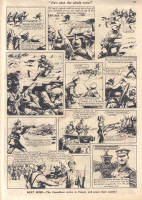

The above images show Bob Millar as drawn by artists (left to right) Farrugia, Ted Rawlings and Leo Rawlings.
See The Victor:-
Writer:- The Victor editorial team. Artists:- Henricus "Harry" Farrugia; Ted Rawlings; Leo Rawlings.
Main cast:- Private (later Corporal, then Sergeant) Bob Millar of the Coldstream Guards.
Time period:- First World War 1914 - 1918.
Bob Millar, a reservist in the Coldstream Guards had completed three years training in the British Army by the time of the outbreak of the First World War in 1914. He and his fellow soldiers were immediately called up and joined the British Expeditionary Force (BEF), in an attempt to halt the German invasion of Belgium and France. This is historically correct. The story below is from issue 214.
 |
 |
 |
He later fought in the trenches and in some of the biggest battles that were fought on the Western Front. He also fought in Gallipoli as a Sergeant attached to the Worcestershire Regiment. (There is a continuity error here as Millar was a Sergeant in Gallipoli in 1915. But he was promoted to the rank of Sergeant again in 1917. Was he demoted back to the ranks for some reason? The series does not say. Note - the Guards did not fight in Gallipoli, hence Millar being on detachment with another regiment).
Millar as a character is very two sided. He does his duty without any criticism of the officers, tactics, conditions they had to fight in. He is the same person at the end of the war, as when he started it. (Despite being shelled, gassed, shot, the stress of going over the top, killing and so on). The strips tell the story of the First World War, but they don’t show the true horror of the trenches. A much more accurate portrayal was provided by the classic war strip Charley’s War written by Pat Mills and artist Joe Colquhoun. (The series is currently being reprinted in hardback editions and can be bought in any good bookshops or via web bookshops). In fairness to this strip though, it was published at a time when it was felt that boys couldn’t be exposed to the full horrors of war and for its time might have been regarded as quite daring. Charley’s War though was published in a more liberal time, so they could get away with more and where necessary defend vigorously what they published.
That's not to say that the Millar series is bad. Far from it. The stories are strong and Millar is placed in different situations, which allow the writers to tell the story of the First World War. Unusually, in boys strips Millar has no regular friends or mates, he always fought alongside for the most part anonymous soldiers. In a lot of stories he is seen taking part in different activities, such as being a sniper, a tunneller, fighting with the tanks and so on. There's plenty to enjoy in this series.
Three of my favourite Victor artists worked on the Millar series and all of them did an excellent job in showing the dangerous and filthy conditions that the troops had to fight in. But for my money even though he illustrated just the one series Ted Rawlings just has his nose in front of Leo Rawlings and Farrugia. Ted Rawlings was in his element in these type of stories and he also drew several poignant stories during his one series run.
The following adventures of Sergeant Millar are from issues 238, 246, 327, 329, 337, 415, 506 and 512 respectively. The first five stories are Millar's adventures on the Western Front, whilst issue 415 has Sergeant Millar showing some of the first inexperienced American officers arriving in France the 'delights' of trench warfare. The final two episodes deal with Millar at Gallipoli.
 |
 |
 |
 |
 |
 |
 |
 |
 |
 |
 |
 |
 |
 |
 |
 |
 |
 |
 |
 |
 |
 |
 |
 |
 |